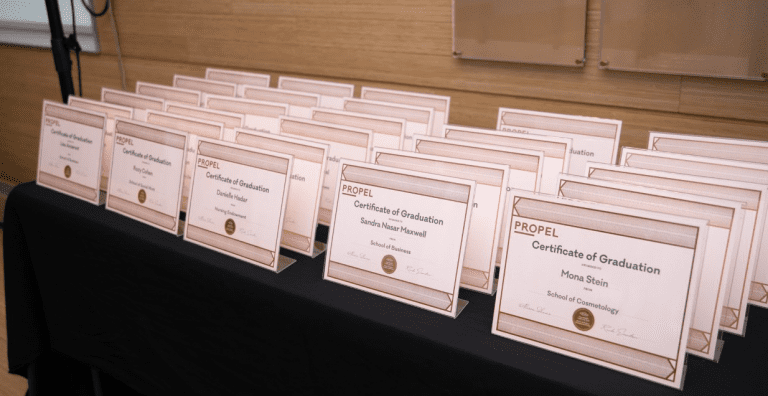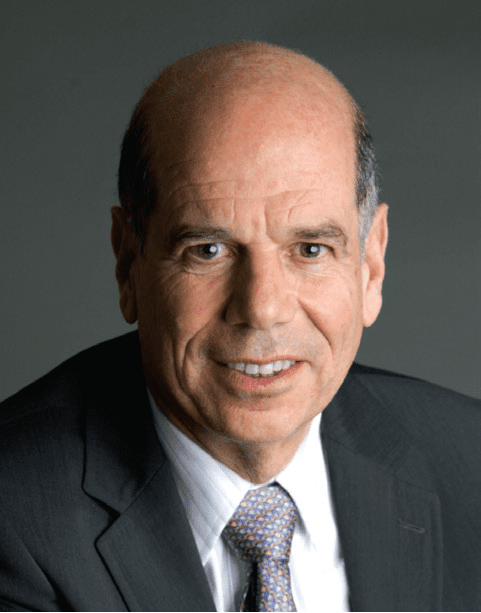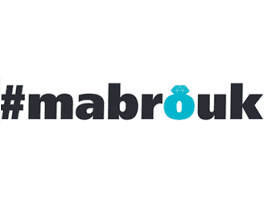This past month, PROPEL hosted its third graduation at The Center. The graduation celebration showcases PROPEL’s accomplishments through the achievements of clients who have completed their certificate studies or educational programs and are now ready to enter the workforce.
The room was full of proud family and friends of the graduates. The graduates were all adorned in their graduation sashes. They were followed by their coaches, Ellen Ades and Gitta Neufeld. Among the guests were PROPEL’s proud board members, President Dr. Gayle Krost, Michael Haddad, Jacqueline Harary, Elaine Parker, and Gitta Kaplan. In addition, many of the mentors from PROPEL’s “Weaving a Network: Women Helping Women,” were in the audience applauding the accomplishments of the PROPEL graduates.
PROPEL’s Co-Executive Directors, Randi Eisenstein and Alissa Shams, and Director of Operations, Viviane Darwish, welcomed the guests, and praised the graduates for all of their successes. They also thanked all those community members who support PROPEL and its mission to inspire, train, and educate women to enter the workforce.
Dr. Gayle Krost, President of the PROPEL Board of Directors, expressed her heartfelt congratulations to the graduates and shared some exciting updates about PROPEL. Over the last six years, PROPEL has coached over 800 women, graduated over 200, and currently assists over 50 women in graduate school.
Ellen Ades, PROPEL’s career coach, proudly introduced Michelle Saad, who inspired the audience with her personal story and accomplishments in the workforce. Michelle, a wife and mother of four, reached out to PROPEL several years ago to hone her professional skills. With Ellen’s guidance, Michelle began taking computer courses, and worked diligently to gain skills essential in today’s workplace. Michelle succeeded in building a career and is proud to be a role model to her children. Michelle’s beautiful testimonial included words from her husband, who sees Michelle as a heroine who tapped into her inner strengths as she re-entered the workforce. PROPEL, Michelle’s husband noted, is the organization that helped her entire family move forward.
Gitta Neufeld, PROPEL’s educational consultant, proudly introduced Sally Baraka. Sally is a PROPEL Ed Touro graduate who is receiving a dual master’s degree in Jewish Education and Special Education. She is currently teaching at Yeshiva Prep and is applying the skills she acquired. During the pandemic, Sally reached out to PROPEL for guidance and help with determining how to best utilize her strengths and experiences. Gitta has helped Sally throughout her educational journey at Touro, and she continues to mentor Sally as she advances in her career.
The keynote speaker and awardee of the evening was Shifra Hanon, a well-known educator at Yeshivah of Flatbush, and namesake of The Shifra Hanon Pathfinders program. In addition to her many heartfelt hesed endeavors, Shifra is very involved in PROPEL’s mentorship program in conjunction with UJA – “Weaving a Network – Women Helping Women.” Evet Ballas, a PROPEL ambassador and entrepreneur extraordinaire (Light Lab Design), spoke beautifully about the many fine character traits that Shifra possesses. The audience was touched when Evet relayed the kindness that she experienced firsthand in high school from Ms. Hanon. Evet was a 14-year-old immigrant, new in this country, with limited English-speaking skills, and Ms. Hanon took her under her wing.
Shifra, a woman of great humility, emotionally accepted the beautiful personalized Eshet Hayil plaque, whose words so befit her. Evet was one of Shifra’s many touch points throughout her career, and they continue to maintain a beautiful and supportive relationship.
Shifra has used her energies and talents to support those around her, and make them feel like they can accomplish anything. She exemplifies mentorship and there is no better PROPEL role model to honor for this accomplishment. Shifra spoke volumes about her love of PROPEL and her continued role as both mentor and advisor to community members.
Most fitting was the establishment of the Shifra Hanon Scholarship Fund. It was so fitting that fund Caroll Dweck Sutton announced the new fund. Shifra’s is Carol’s protégée and beloved colleague at Yeshiva of Flatbush.
The graduation concluded with the presentation of certificates by PROPEL’s board members. Receiving those certificates, testifying to the students’ perseverance and success, proved to be an incredibly proud moment for both PROPEL graduates and supporters alike. The song We Are The Champions rang loudly as the audience cheered during the closing montage, showcasing the accomplishments of the multi-faceted organization that is PROPEL.
_________________________________________
PROPEL 646-494-0822 | info@thepropelnetwork.org | Instagram @PropelNetwork
Please reach out to PROPEL:
*If you are interested in a career or career advice; PROPEL can help you take the steps to fulfill your professional goals and dreams.
*If you are interested in joining PROPEL’s cohort of mentors in PROPEL’s “Weaving a Network: Women Helping Women” program or being paired with a mentor.












